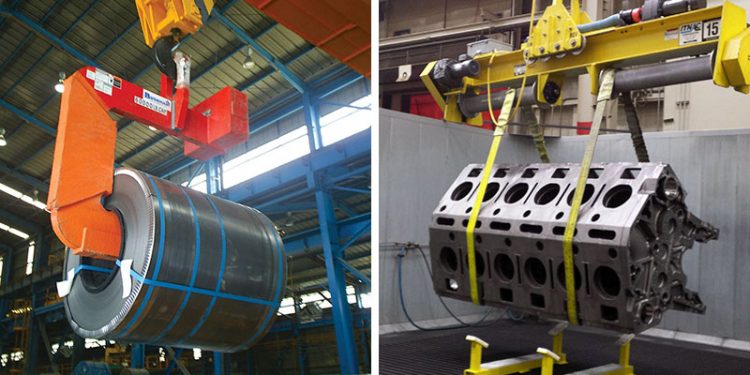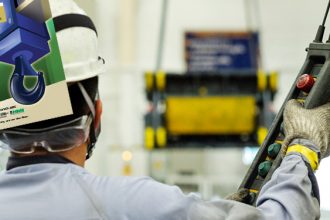
When attached to an overhead crane or monorail’s hoist, below-the-hook lifting devices (also called attachments or end effectors) ensure that a specific type of load can be lifted, lowered, and positioned safely and securely. Below-the-hook lifting devices are offered by overhead handling equipment manufacturers in both standard and custom engineered designs that match the specific requirements or features of the load.
Whether the attachment is a structural lifter (with a static, rigid structure that includes 2- or 4-point lifting beams, C-hooks, and pallet lifters) or a mechanical lifter powered manually, electrically, pneumatically, or hydraulically to securely attach to the load, it is important that the equipment operator is trained on its safe operation. Additionally, owners of below-the-hook lifting devices have a variety of responsibilities that are critical to the safe operation of this equipment. That’s why the members of the Crane Manufacturers Association of America (CMAA) recently published CMAA Specification 80 – Below-The-Hook Lifting Device Operator’s Manual. The document is recommended for use as a complement to CMAA Specification 79 – Crane Operator’s Manual, as well as in conjunction with the operating instructions and maintenance manuals provided by the equipment manufacturer(s).
Additionally, CMAA has assembled a list of below-the-hook equipment “Dos and Don’ts.” Following these recommendations will enhance both the integrity and reliability of the equipment, as well as reduce the risk of injury for workers as they operate the attachment or work in proximity to it.
Below-The-Hook Equipment Dos…
- Do read the owner’s manual. These informational documents — developed by the below-the-hook lifting device manufacturer — contain specifications, dimensions, operation instructions, inspection criteria, parts lists, and more.
- Do understand that the Occupational Safety and Health Administration (OSHA) requires facility operators to provide their employees with equipment that is both safe and operates property.
- Do require the operator to visually inspect the below-the-hook device prior to the start of each shift before operation, to ascertain the condition and functionality of the controls, all rigging, indicators, meters on the device, as well as look for debris on load and lifting surfaces.
- Do follow these procedures before using the device and engaging the load:
- Verify all equipment adjustments are correct and secure.
- Verify all rigging hardware and methods are correct.
- Confirm all lifting attachments are free from twists, kinks, or damage.
- Ensure the load can withstand forces applied by the lifting device.
- Attach the load as directed by the manufacturer’s instructions.
- Confirm the weight of the load does not exceed the rated capacity of the lifting device.
- Confirm that the combined weight of the load and lifting device does not exceed the rated capacity of the hoist, crane, or monorail.
- Verify the lifting device is fully seated in the crane hook.
- Ensure the load is balanced and fully engaged by the lifting device during hoisting or travel.
- Confirm the travel path is clear of personnel and obstructions.
- Verify that the device and load will clear all obstacles while lifting, lowering, rotating, or transporting a load.
- Do accelerate and decelerate a loaded or unloaded below-the-hook device slowly and smoothly while lifting, lowering, rotating, or transporting.
- Do lift, lower, rotate, and transport a loaded or unloaded device in a controlled manner, over a pre-determined travel path, and onto a suitable supporting surface.
- Do understand that below-the-hook devices used in harsh environments and/or with a higher duty cycle will require frequent and periodic inspections to be performed more often.
- Do perform regular preventive maintenance as specified by the device manufacturer to ensure long service life.
- Do ensure all employees/operators who will use the below-the-hook lifting device have been trained on its proper use and operation by someone who has experience with the equipment.
- Do follow all safety precautions specified by the manufacturer of the device when operating the equipment.
Below-The-Hook Equipment Don’ts…
- Do not misplace or throw away the owner’s manual. This document is a critical resource for owners and operators of below-the-hook lifting devices.
- Do not allow an operator to rig a load without first having proper training.
- Do not attempt to lift a load that exceeds the capacity rating of the below-the-hook device.
- Do not operate any lifting device that is damaged or has any actual or suspected mechanical or electrical malfunction.
- Do not use the below-the-hook device more frequently than its duty cycle specifies.
- Do not lift, lower, rotate, or transport personnel with the device.
- Do not lift, lower, rotate, or transport a load with the lifting device until all personnel, including the operator, are clear of the load and its path.
- Do not shock load the lifting device
- Do not hoist or transport a loaded or unloaded lifting device over personnel.
- Do not permit personnel to enter swing zones, fall zones, or crush zones.
- Do not drag, push, or side-pull a loaded or unloaded lifting device.
- Do not adjust or repair a below-the-hook lifting device unless qualified to perform such maintenance
- Do not use the lifting device as a ground for welding; do not allow a welding electrode to contact the device.
- Do not remove or obscure safety placards or labels on the device.
- Do not modify or disable any mechanical, structural, or electrical features or components on the device.
- Do not allow untrained operators to use the below-the-hook lifting device.
Looking for more information on overhead crane systems? Available to answer any questions, CMAA members represent the industry’s leading suppliers of overhead crane systems. With the combined experience of more than 30,000 crane installations in North America over the last decade, CMAA members are committed to providing products focused on both safety and innovation. Additionally, the group offers a variety of resources — including buyers’ guides, engineering specifications, OSHA Alliance safety tip and fact sheets, inspection and maintenance checklists, safety seminars and more — via its website at www.MHI.org/CMAA.



